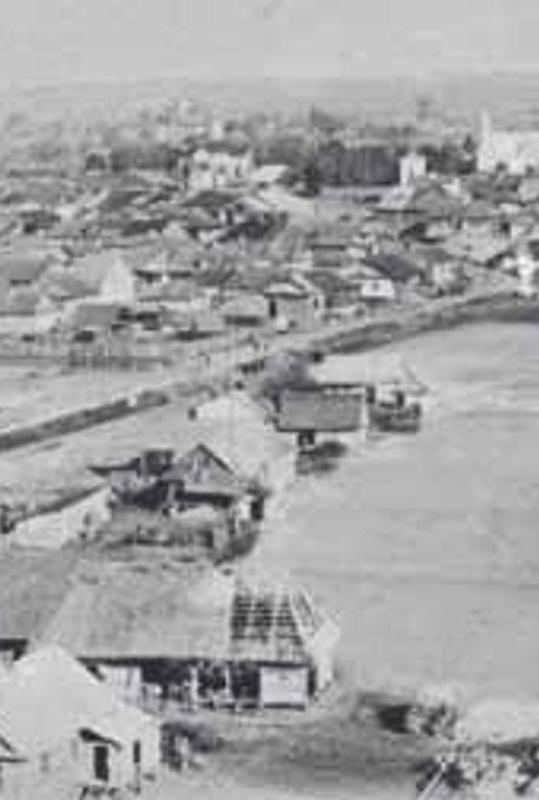Jews in Grabowiec - Until 1918. - The first Jews appeared in Grabowiec probably around 1569.In 1630. 20 Jews lived here, occupying one house together. Over the next several decades, the Jewish population became the largest ethnic-religious group in the city.They made their living mainly from the honey trade, taverns and arends, as well as usury. In the 18th century. They bought up houses and plots of land located around the market square and thus pushed the Christian population out of the city center. In 1765. directly adjacent to the market, there were 13 Jewish houses, and at a slightly further distance - another 19.Around 1716. A synagogue was built, while ca. 1720 r. The first cemetery was delineated, which allows us to assume that before the middle of the 18th century. An independent municipality could have been established here. In the years 1799-1806 (i.e. during the period when Grabowiec belonged to the Austrian partition), a Deutschjudische Schule (German-Jewish School) functioned there.The teachers of this school were B. Bart (1799), H. Feld (1806). In the 19th century. A mikvah and a beit ha- midrash were built.In 1891. A new cemetery was established, which was actively used until 1942.In the 19th century. The Jews made their living through trade, crafts, exquisition and wagon-making. Among the Jewish residents of Grabowiec, the influence of Hasidism was strong - there were shtibles that associated followers of various tzaddikim.Interwar period - Most of the local Jewish community consisted of small merchants and poor artisans - shoemakers, tailors, kamashniks, butchers and bakers. A number of wealthy merchants lived here, engaged in the grain trade, owning larger mud stores and confectionery warehouses.Many supporters among the younger generation of Grabowiec Jews had the Bund and Zionist organizations. Prior to the outbreak of World War II, the local community owned a synagogue, a beit ha- midrash and two cemeteries.The community co-financed the activities of aid institutions, including. Linas ha-Cedek and Gemilut Chesed. There were several private beit ha-midrash, seven cheders and a Jewish library, which was run by Moszko-Kiwa Fink.In the second half of the 1920s, a local branch of the Tarbut association was founded, conducting cultural and educational activities. The association "Jawne" from the early 1930s to 1938. ran an elementary Hebrew school in Grabowiec. In the early 1930s, a branch of the "Frajhajt" Cultural and Educational Society was established, influenced by the Poale Zion party and running, among other things. adult education courses.Holocaust - In early October 1939. With the retreating Red Army to the east, several hundred Jews from Grabowiec fled. In 1940. A Judenrat was established, headed by local shoemaker Jankiel Szlajer.In 1941 the Germans created a ghetto for about 2,000 Jews. On May 1 of that year, several hundred Jews from the communities of Miączyn, Werbkowice, Molodiatycze were resettled in Grabowiec.In May 1942. carried out the first execution, in which they shot 33 Jews. On June 8, the Jews of Grabowiec were herded to the railroad station in Miączyn, from where 1,200 were sent to the Sobibor death camp.The remaining 850 Jews were allowed to return to the ghetto. All were sent to forced labor.Most worked on the farm, some in the sawmill in Verbkowice, and about 100 craftsmen found employment with local foremen. The final liquidation of the ghetto took place in mid-October 1942.The Germans drove all the Jews to the Hrubieszow ghetto, from where most of them were sent to Sobibor on October 28. A small number of Jewish families from Grabowiec survived the occupation by hiding in forest hideouts or enlisting the help of the Christian population.As the mayor of Grabowiec, Jozef Sebowicz, reported to county authorities, local Jews supported the January Uprising. Mayor's report of November 27, 1861. sent to the district chief in Hrubieszow read: , "For a week a number of local residents, instigated as it turns out by the Old Jewish Josia Sztechel, whether for insubordination or restlessness or other intentions, in the city sought shelter after houses at night and in the churches by the dozen had their secret meetings. In February 1862. A proclamation in Hebrew, calling for cooperation with Polish insurgents, appeared in the Grabowiec synagogue.
1. Grabowiec - Centrum miejscowości
Stories
Grabowiec - center of the village
Jewish History Tours

Powered by Clio Muse Tours
Powered by Clio Muse Tours
